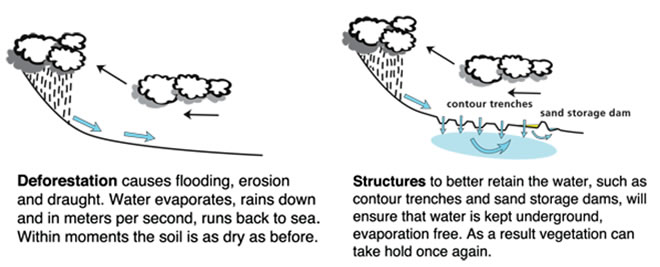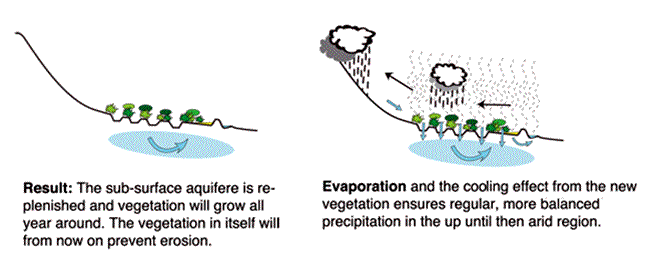To tackle drought and desertification, Somalia has to utilize its water resources
by Mohamud Haji Elmi
Wednesday, April 17, 2013
Water is the most abundant compound (H2O) on the surface of earth. Without it life would cease to exist. It is distributed across the earth in the ocean (97.13%), the polar ice caps (2.24%), the groundwater (0.61%), and surface water (0.02%) (Eisenberg an kauzman, 1969, Franks 2000).
The information above tells us that ground water is abundant 30 times than surface water, nevertheless many people have the perception that surface water occupy greater volume than groundwater, and remain to believe that rivers and lakes are the only sources of water to depend for their livelihood. This is what is happening now and will continue to happen as far as the poor countries do not have enough technology and money to access ground water. Indeed there is lack of interest to invest on the utilization of the groundwater; it is not that there is scarcity of water in this planet.
For decades Somalia is affected by frequent droughts; without adequate preparation it is impossible to prevent the impact of droughts on rural population. In my experience in the rural area most men go for search of water during the dry season walking for at least 20 km away from his home daily, loading over 100 liters on the two sides of his camel. Unfortunately this is not even a potable water therefore, people develop all sorts of diseases including deadly cholera.
Somalia possesses a huge groundwater resources and it is estimated to be 12,300 Km; it ranges from 5,210 to 34,500 Km³, ranking Somalia as the 14th largest country in Africa. This massive presence of ground water can transform the entire landscape into a green piece of earth if it is managed properly. Somali communities can be relieved of despair and poverty and enjoy prosperity by utilizing the immense resources the country has. Somalia today is quite different than it was 50 years ago – now it has a potential human resources and capital investment than any other time in contemporary history, and there is a great chance of reclaiming its dignity and nationhood.
Exploiting ground water could reduce poverty, and create friendlier environment in many parts of Africa, especially sub-Saharan countries. This could be done by encouraging drought resistant farming, where communities will depend on their local wells to cultivate and raise their livestock hundreds of miles away from the rivers, and that could be the beginning of creating more prosperous and stable communities.
Groundwater is a critical component of water resources management. The Environmental Protection Agency (USEPA 2000) reported that in the United States.
- Approximately 40% of river flow depend on groundwater,
- About 50% of Americans obtain their drinking water from groundwater.
- Approximately 95% of rural residents rely on groundwater for their drinking supply
- About 50% of agricultural water comes from groundwater
It is essential to improve the water collection capacity of soil in order to tackle desertification and soil erosion. This is achieved with the help of so-called contour trenches. These are trenches that follow the contours of the landscape and capture the rainwater flowing downwards above ground. Using these trenches, destructive above-ground water flows no longer erode the soil; wash away the fertile top soil and any vegetation still present. These trenches mean that water flows underground, resulting in the creation of an underground water supply. This underground water supply is used not only as drinking water by humans and animals, but also stimulates the growth of natural vegetation and of the agricultural crops planted. Besides laying contour trenches, a number of other elements are introduced – stone walls and tree coppicing, for example – which optimizes the effective water-holding capacity of the flow area, erosion is stopped and regulated evaporation is responsible for the achievement of a better local and regional climate.
This new technology called continuous contour trenches could have a long lasting impact to prevent drought, desertification, and food scarcity. Water resources can be renewed by using this technology enabling fresh water not only for human consumption but also for animals and agricultural use.
This multifunctional approach to water and climate management was developed by Peter Westerveld . Since the 1990s, his Trust has successfully transformed this technique into practice by collaborating with local communities in East Africa. In semi-arid areas, the improvement of storing water supplies from underground, free of any evaporation loss, results in the continuous availability of both drinking water and vegetation that is always green. In this way, agricultural production can be increased as part of a sustainable approach. Below are illustrations showing how the contour trenches technology works.


T o realize this project following machines are required
The machines required
|
Machine Type |
cost |
|
2- 3 Scavater360° degree cat 13 ton |
£ 27000- 30000 EACH |
|
2 bulldozer D 7 OR D6 Cat |
£35000 EACH |
|
2 Scavater 180° 3CX (JCB) OR 432E CAT |
£ 54000 2 0F THEM |
|
DUMPER 3 -4 TON |
£7000 |
|
1.Concrete Mixer |
|
|
20 Will Bars & 40 shovels (Badiillo) |
|
|
4.Generators |
|
Maintenance
Hydrolic 40 Oil ----------------------------------------------- 600 Liters or 3 Barrels
1 Barrel = 200 Liters Van Equipped with all maintenance tools £ 1200 - £15000
1. High qualified technicia ------------------------- Salary- $ 3000/Month
Mohamud Haji Elmi, UK London
Email: [email protected]